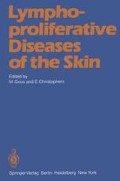Abstract
The last decade has witnessed great advances in the investigation and study of the lymphoreticular system. In particular, new methods of cell identification have allowed us to group certain diseases together as disorders of a particular cell type. In this way, mycosis fungoides, Sézary syndrome, and certain other skin disorders previously described as “reticulum cell sarcoma”, “well differentiated lymphocytic lymphoma”, or “histiocytic lymphoma” have been unified as manifestations of malignant T cell proliferations [1,2,3]. The frequency with which lymphoreticular neoplasms involving broad expanses of skin are T cell malignancies is in marked contrast to those which spare the skin. In adults, lymphocytic malignancies which do not have prominent associated skin infiltration are most commonly proliferations of B cells [4].
Supported by NIH Grants CA 20499, CA 13696 and RR 00645
Access this chapter
Tax calculation will be finalised at checkout
Purchases are for personal use only
Preview
Unable to display preview. Download preview PDF.
References
Edelson RL, Smith RW, Frank MM, Green I (1973) Identification of subpopulations of mononuclear cells in cutaneous infiltrates. J Invest Dermatol 61: 82
Chu AC, MacDonald DM (1979) Identification in situ of T lymphocytes in dermal and epidermal infiltrates of mycosis fungoides. Br J Dermatol 100: 177
Schmitt D, Alario A, Thivolet J (1979) In situ characterization of tissue cells of cutaneous infiltrates using specific membrane antigens. Clin Exp Dermatol 4: 161
Lukes RJ, Collins RD (1974) Immunologic characterization of human malignant lymphomas. Cancer 34: 1488
Edelson RL (1975) (NIH Conference) Cutaneous T cell lymphomas. Perspective. Ann Intern Med 83: 568
Lamberg SI, Bunn PA, Jr, eds (1979) Proceedings of the workshop on cutaneous T cell lymphomas (mycosis fungoides and Sézary syndrome). Cancer Treat Rep 63: 561
Tan RS, By o NA, Hayes, JP (1975) A method of liberating living cells from the dermal infiltrates: studies on skin reticuloses and lichen planus. Br J Dermatol 93: 271
Sterry W, Steigleder GK, Pullman H (1980) In situ identification and enumeration of T lymphocytes in cutaneous T cell lymphomas by demonstration of granular activity of acid non-specific esterase. Br J Dermatol 103: 67
Chu AC, Morgan EW, MacDonald DM (1981) Ultrastructural identification of T lymphocytes in tissue sections of mycosis fungoides. J Invest Dermatol 74: 17
Schmitt D, Viac J, Brochier J, Thivolet J (1976) Thymus derived origin of Sézary cells demonstrated by peroxidase conjugated anti HTLA serum. Acta Derm venered 56: 489
Kung P, Goldstein G, Reinherz EL, Schlossman SF (1979) Monoclonal antibodies defining distinctive human T cell surface antigens. Science 206: 347
Reinherz EL, Kung P, Goldstein G, Levey RH, Schlossman SF (1980) Discrete stages of human intrathymic differentiation: Analysis of normal thymocytes and leukemic lymphoblasts of T cell lineage. Proc Natl Acad Sci 77: 1588
Reinherz EL, Kung PC, Goldstein G, Schlossman SF (1979) Separation of functional subsets of human T cells by a monoclonal antibody. Proc Natl Acad Sci 76: 4061
Reinherz EL, Kung PC, Goldstein G, Schlossman SF (1979) A monoclonal antibody with selective reactivity with functionally mature human thymocytes and all peripheral human T cells. J Immunol 123: 1312
Kung PC, Talle MA, DeMaria ME, Butler MS, Lifter J, Goldstein G (in press) Strategies for generating monoclonal antibodies defining human T lymphocytes differentiation antigens. Transplant Proc
Kung PC, Goldstein G (in press) Functional and developmental compartments of human T lymphocytes. Vox Sanguinis
Reinherz EL, King PC, Goldstein G, Schlossman SF (1980) A monoclonal antibody reactive with the human cytotoxic/ suppressor T cell subset previously defined by a heteroantiserum termed TH2. J Immunol 124: 1301
Breard J, Reinherz EL, Kung PC, Goldstein G, Schlossman SF (1980) A monoclonal antibody reactive with human peripheral blood monocytes. J Immunol 124: 1943
Broder S, Edelson R, Lutzner M, Nelson O, McDermott R, Durm M, Goldman C, Meade B, Waldmann T (1976) The Sézary syndrome. A malignant proliferation of helper T cells. J Clin Invest 58: 1297
Chu AC, MacDonald DM (1980) Pagetoid reticulosis: a disease of histiocytic origin. Br J Dermatol 103: 147
Fithian E, Kung P, Goldstein G, Rubenfeld M, Fenoglio C, Edelson R (in press) Reactivity of Langerhans cells with hybridoma antibody. Proc Natl Acad Sci
Goos M, Kaiserling E, Lennert K (1976) Mycosis fungoides: Model for T-Lymphocyte homing to the skin? Br J Derm 94: 221
Thorbecke G, Silberberg-Sinakin I, Flotte TJ (1980) Langerhans cells as macrophages in skin and lymphoid organs. J Invest Dermatol 75: 32
Rubenfeld MR, Edelson RL, Lofstrom LM, Berger CL, Warburton D (1980) Neoplastic human T cells capable of responding to multiple human alloantigens. Blood 55: 470
Rowden G, Lewis MG, Sullivan AK (1977) Ia antigen expression on human epidermal Langerhans cells. Nature 268: 247
Tamaki K, Katz S (1980) Ontogeny of Langerhans cells. J Invest Dermatol 75: 12
Safai B, Dardenne M, Incefy GS, et al (1971) Circulating thymic factor, facteur thymique serique ( FTS), in mycosis fungoides and Sézary syndrome. Clin Immunol Immunopathol 13: 402
Editor information
Editors and Affiliations
Rights and permissions
Copyright information
© 1982 Springer-Verlag Berlin Heidelberg
About this paper
Cite this paper
Chu, A., Berger, C.L., Lynfield, Y., Esseesse, I., Edelson, R.L. (1982). Pathogenesis of Cutaneous T Cell Lymphoma. In: Goos, M., Christophers, E. (eds) Lymphoproliferative Diseases of the Skin. Springer, Berlin, Heidelberg. https://doi.org/10.1007/978-3-642-68363-3_6
Download citation
DOI: https://doi.org/10.1007/978-3-642-68363-3_6
Publisher Name: Springer, Berlin, Heidelberg
Print ISBN: 978-3-540-11222-8
Online ISBN: 978-3-642-68363-3
eBook Packages: Springer Book Archive

